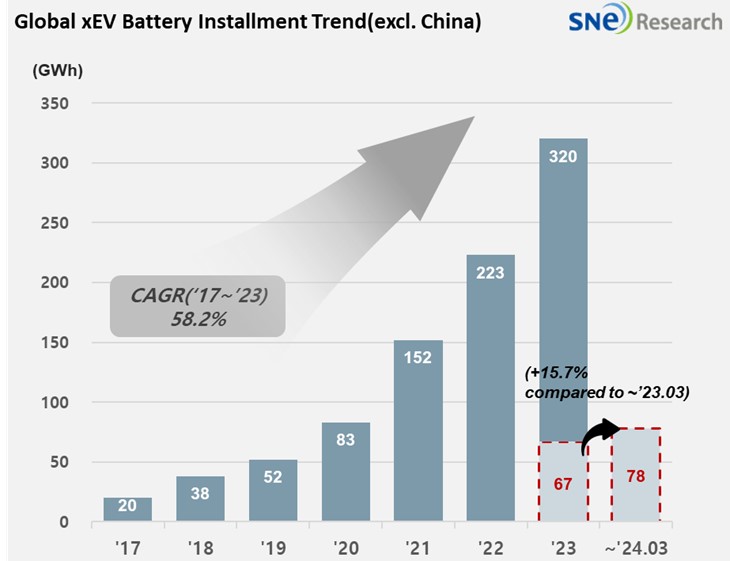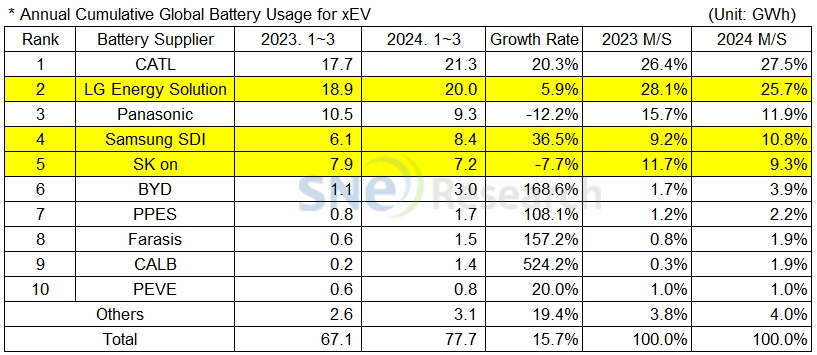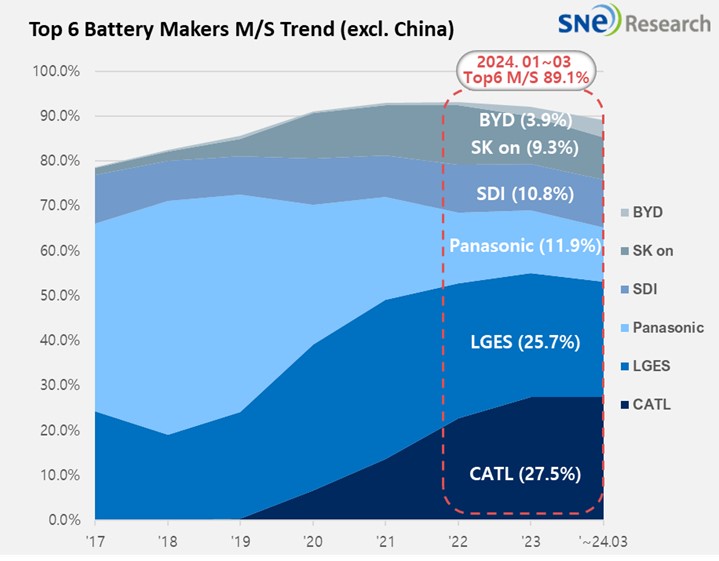From Jan to Mar 2024, Non-Chinese Global[1] EV Battery Usage[2] Posted 77.7GWh, a 15.7% YoY Growth
- K-trio accounted for 45.9% M/S from Jan to Mar 2024
Battery installation for
global electric vehicles (EV, PHEV, HEV) excluding the Chinese market sold from
January to March in 2024 was approx. 77.7GWh, a 15.7% YoY growth.

(Source: Global EV and Battery Monthly Tracker – April 2024, SNE Research)
In the ranking of battery usage for electric vehicles, the K-trio battery makers all ranked within the top 5. LG Energy Solution ranked 2nd with a 5.9%(20.0GWh) YoY growth. Samsung SDI posted the highest growth of 36.5%(8.4GWh) among the K-trio battery makers, while SK on posted a 7.7%(7.2GWh) YoY degrowth.

(Source: Global EV and Battery Monthly Tracker – April 2024, SNE Research)
The combined shares of K-trio recorded 45.9%, a 3.1%p YoY decline. If we look at the usage of K-trio battery in line with the sales volume of electric vehicles, Samsung SDI continued to be in an upward trajectory thanks to solid sales of BMW i4/5/X and Audi Q8 e-Tron and PHEV in Europe and high sales of Rivian R1T/R1S in North America. Despite the increase in sales of Ford F-150, Hyundai IONIQ 5, and KIA EV9 in North America, SK On posted a degrowth affected by poor sales of Hyundai IONIQ 5 and KIA EV6 in Europe and Asia (excl. China). However, with the solid sales of Mercedes EQ line-up and the global sales expansion of KIA EV9, the battery makers would return to the growing trend. LG Energy Solution’s growth was led by sales of bestselling vehicles in Europe and North America such as Tesla Model 3/Y, Ford Mustang Mach-E, and GM Lyriq.
Panasonic recorded 9.3GWh of its battery used from Jan to Mar 2024, posting a 12.2% YoY degrowth. The degrowth of Panasonic, one of the major battery suppliers to Tesla, was mainly led by a temporary slowdown in sales due to partial change in Model 3. On the other hand, it has most of its battery usage installed in Tesla Model Y in the North America. As it has been reported that Panasonic would release advanced 2170 and 4680 cells, it is expected to expand its market share mostly focusing on Tesla.
CATL, which has been rapidly expanding its share even in the non-China market, captured the leading position with a continuous high growth of 20.3% (21.3GWh) YoY. CATL’s battery is installed to Tesla Model 3/Y(made in China and exported to Europe, North America, and Asia) as well as vehicles made by major OEMs such as BMW, MG, Mercedes, and Volvo. As Hyundai Motors adopted CATL’s battery for KONA, Niro, and Kia Ray EV, CATL has been gradually increasing its influence in the Korean domestic market.

(Source: Global EV and Battery Monthly Tracker – April 2024, SNE Research)
With the global EV market has slowed down since the end of 2023, major OEMs such as Tesla, Mercedes, Volkswagen, and GM have revoked or postponed their plans related to electric vehicles. In addition, the regulations on fuel efficiency have been eased in different countries and subsidies for electric vehicles were reduced. All of these circumstances have created a concern about the electric vehicle market, but it is only a matter of time before the car industry eventually go electric. The US market, where the competition with China is relatively less fierce, is the most important market for the Korean battery makers to target. Later in North America, the K-trio is expected to expand their market shares through establishing joint ventures with OEMs who manufacture their vehicles locally.
[2] Based on battery installation for xEV registered during the relevant period.

